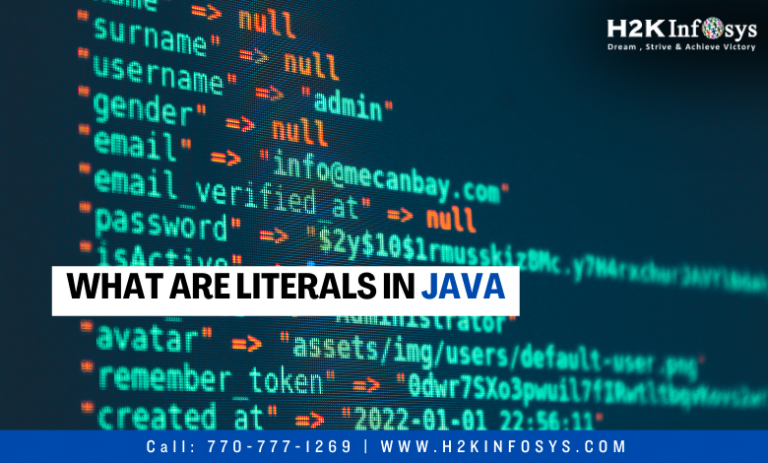As a Java programmer, one important skill to learn is how to optimise programming for memory, speed, and efficiency. Now, variables in Java are important especially when you are programming to store your data at a specific memory location. You can use them to store values when executing your programs. One important thing to note in Java programming is obeying specific conventions when naming your variables and assigning your values. This will make it easy for your reader to understand your program. This is where Literal in Java comes in. “Literal” refers to a source code that represents a fixed value in Java.
When using Literals in Java, you don’t need any form of processing because they are defined directly in the code. You can use them to assign variables of any primitive type. Programming in Java is object-oriented, generic, class-based, reflective, imperative, and multi-paradigm.
The representation of literals in Java is undefined. There are various ways to represent literals in Java. Character, numeric, string, or boolean data could be used to represent them. In Java, literals represent a sort of data type that includes fixed values that are also temporarily assigned.
In Java, literals are source code that stand for predefined values. Any sort of primitive variable could be assigned to these literals.
There are two types of data in one of the most widely used programming languages: primitive and non-primitive. While arrays, strings, and classes are examples of non-primitive data types, primitive data types include int, byte, short, float, boolean, double, and char.
Certain signed integer values are represented by the Java primitive literals int, byte, short, float, boolean, double, and char. Examples include the 8-bit signed byte data type, the 16-bit signed short data type, the 32-bit signed int data type, the 64-bit long data type, the 32-bit signed float data type, the 64-bit double data type, the boolean data type with only two possible values—true or false—and the 16-bit unicode character, char.
Literal in Java is the main subject of this article. This means you will learn the fundamentals of Literals in Java. Check out our Java training to learn more.
What are Literals in Java?
A synthetic representation of boolean, numeric, character, or string data is known as literal in Java. It is a way for the program to express specific values. For example, in the following statement, an integer variable called “count” is given an integer value.
int count = 0;
A literal ‘0’ represents the value zero.
As a result, a constant value that is set to a variable is referred to as literal. Before anything else, though, one needs to understand how to define literals in Java and have a basic understanding of what a literal in Java programming is.
Now that the definition of literals has been clarified, let’s see how literals are used in Java and the various types of literals. The literals are represented directly in the code; no computation is required. They also make the process easier and may be applied to any kind of primitive variable, which makes the task go more smoothly.
Why do you use Literal in Java?
Now that you know what literal in Java means, learn why you as a Java programmer should use them in your codes.
Because they eliminate the need to declare constants and add labels to the same line, Java’s multiple literal types are especially useful for code implementation.
1.Readability and Clarity
Java literals are brief and straightforward ways to express constant values, which greatly improve the readability and clarity of code. A literal in the code, whether it be numeric, text, or boolean, provides an instantaneous and unambiguous indicator of the value in question without requiring you to understand complicated formulas. This makes it easier for developers to understand and promotes teamwork when coding.
2.Efficient Data Representation
For data to be represented effectively, especially numerical numbers, literals are needed. Developers can avoid ambiguity and potential precision issues by explicitly declaring the type of numeric literal (int, float, or double). Because of the precision with which this code is written, there is less chance of unexpected effects arising from implicit conversions or data type mismatches.
3.Enhanced Maintenance and Debugging
Literals are important in debugging and maintaining code. During debugging, what the literal value does is that it provides a simple point of reference. This will make you understand the status of variables or constants. Also, Literals makes use of a uniform codebase which makes it easier for you to find possible mistakes or inconsistencies quickly during maintenance, which speeds up the debugging process.
4.Facilitating Code Modifications
Another good feature about Literals in Java is that it provides easy modification, which adds to the flexibility of the code. It is very simple for you to modify a constant value when using Literals. So in situations where you have to change the parameters or constants, you can quickly change the code without error.
5.Encouraging Best Practices
As a Java programmer, you have to always follow the best practices of Java. Using literals which encourages uniform code styles is one the best practices. Imagine if all Java developers follow the same convention, it will be easier to work with other Java programmers in uniformity. It turns into a common language that promotes collaboration among developers and, in the end, results in the production of reliable and maintainable software.
Conclusion
To learn more about Literals in Java, you can check out Java courses online.




























